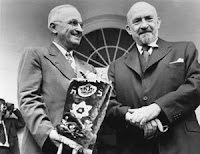By 2000, I had dismantled two households that each lasted
more than fifty years: my parents and my
in-laws. Since then I was responsible
for moving my aunt from a series of apartments and finally
into a nursing home.
Each time, I have been forced to give a lot of thought to
what material objects mean to me and others.
For my aunt, who had hundreds of swizzle sticks, 40 black skirts, 65 pairs of black leather
gloves, and no savings, they represented the freedom to spend her hard-earned
money on herself, to be stylish, to eat at the newest restaurant, to follow her
whims. (I also credit her for my first New Yorker subscription while I was away at college, a subscription that continues to this day.)
Now I am in serious discarding mode, as I described in my
last blog about donating my mother's letters to the American Jewish Archives. In February I was declared
"disease-free"; in May I learned that my cancer had returned and
instead of a discrete mass was now an uncountable number of tumorlets in both
lungs. I first underwent testing to see
if I was a candidate for a relatively new drug.
I took it, but at the three-week mark I had to be hospitalized.
Since July, I have been back on conventional
chemotherapy. Our
post-retirement plan to travel the world has been shelved.Discarding has become my life’s work. It is what I do when I'm not sitting in
doctors' offices.
Discarding is very hard work, especially if you believe that
everything has a place but not necessarily a price. I just want to find people who will cherish
what I have. Ebay is of no interest to me: no time, no desire, no patience.
There are clothes that I should have discarded earlier. Even groups like Suited for Change or Dress for Success don’t want
anything more than two years old, no matter how timeless it is, and certainly the consignment stores demand
fresh blood – I mean merchandise – dry-cleaned, inventoried, photographed.
 Most of my “stuff” is paper:
my father’s mystery books, my Classics Illustrated, Playbills, and New
Yorker covers.
Most of my “stuff” is paper:
my father’s mystery books, my Classics Illustrated, Playbills, and New
Yorker covers.
Finding the right home can be enormously gratifying.
One of the first pieces I “placed” was a 1940 map of California’s
John Muir Woods.
Shortly after they married on November 16, 1941, while my
father-in-law was serving in the Pacific, my mother-in-law moved to San Francisco. She never
stopped talking about those two years:
released from her large family, she tasted
independence in exotic northern California.
Among her possessions when she died, I found the map, a free
souvenir of a long-ago adventure. When I
sent it to officials at the Woods, they were excited: the map showed trails they hadn’t known
existed.
That convinced my husband to write to the Consul General of
Tonga and offer his father’s photo album filled with what turned out to be rare
snapshots of Tongan life in the 1940s and is now in the Tonga National Museum.
I found my grandfather’s Northwestern University Pharmacy
School Class of 1904 graduation photo and contacted NU’s archivist. That turned out to be one of their “missing”
years, and in return for the photo, the archivist copied my grandfather’s
letter of application – and his transcripts – and sent them to me.
 | |
| Hyman Sime, 2nd from left |
Finding appreciative recipients is gratifying because it
validates the importance I have put on these items and justifies my saving
them. Without the internet, my
“placement” of various items would be possible but incredibly difficult.
More important, however, I am coming to realize, is my own life
review. I cannot control what will happen in the
future, but I can better understand my past.
So far, my curiosity it has helped me to face the next day and the next day and get
up each morning.












